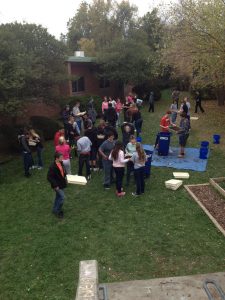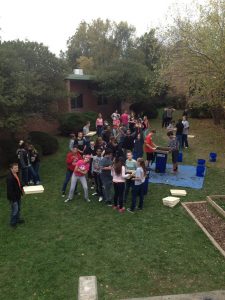Final report for YENC14-073
Project Information
DESCRIPTION AND RESULTS
Purdue Extension-Marion County worked with urban middle and high school youth with the goal of providing them with an understanding of sustainable agriculture. Our teaching plan for the overall theme of sustainable agriculture was composting. Not on the massive “farm/ranch” based scenario but in the realistically urban ‘garden-based’ setting, and focused on best practices of home-based composting. We facilitated our project through Beech Grove’s Agriculture-Science school programs. The project was implemented by the 4 teachers who teach the classes. They agreed to integrate sustainable agriculture and composting education, experiments, collection of cafeteria waste and lesson plans into the school-day curriculum. Having teacher involvement was instrumental as it helped to broaden both the learning and composting experiential education on a daily basis. The youth learned about composting best practices; how to use composting in their school gardens; and how to use the school lunch wastes.
We reviewed educational material the teachers used as well at providing assorted bulletin-type publications that largely will be used as references for ‘best-practices’, assuring future success. Teachers were given the National 4-H Grab And Go: Composting, and encouraged to incorporate the National FFA mentoring guide (PALS)/composting/Teamwork unit publication.
Sustainable agriculture practices that the students learned about are:
- Water Conservation and water run-off control
- Reduce fossil-fuel energy use
- Reduce yard and garden waste in a sound way
- Plant selection and maintenance
- Garden design
Beech Grove Middle School built raised garden beds in conjunction with this grant. The students will be using the sustainable Ag practices they learned about when they garden in 2016. Examples of what they have thought about using are:
-
- No-till and hand pull weeds (fossil fuel usage reduction)
-
- Drip irrigation (conserve water and no run-off)
-
- Compost garden waste (useful way to dispose of plant waste)
The students built and managed four compost units – one at each school. They had originally planned on composting using open containers but the school’s principal was afraid that it would smell. So the composting was done in large, closed bins with worms. The students were then charged with maintaining the compost by participating in day-to-day operations, problem solving such as layering, turning, etc., data collection and journaling progress. The refuse used in the compost bins was collected from the cafeteria with weight and type of material recorded.
Students documented the project with photographs, measurements, observations, and anecdotes. In September, 2015, each group of students created photo documentaries that explain the project and best practices. These were presented to students at the Beech Grove Middle School. In addition, students have used the photo documentaries as PSA’s on social media.
They had hoped to do presentations in the community about how to compost but ran out of time during the school year.
The four presenters who spoke to the students provided different aspects of sustainable agriculture. The presentations were recorded and other students were offered the opportunity to watch them.
-Matthew Jose of Big City Farms discussed how he farms in polluted soils in the inner city. Because of this, he has to make and use tons of compost to remediate the soil and provide a healthy growing environment for the plants.
-Laura Henderson of Growing Places Indy discussed their no-till farm's, water collection and drip irrigation. She also talked about using edible plants in the landscape.
-Tyler Gough of Indy Urban Acres talked about the reuse of everything on the land, no-till and crop rotation.
- Jessica Davis, Director Office of Sustainability IUPUI, discussed initiatives at the school that were put in place to conserve resources.
Students involved with the project took pre/post-tests that measured knowledge gained on compost importance, production and role in sustainable agriculture settings. 250 students took the tests. The scores improved from 57% average on the pre-test to 81% average on the post-test. Students exhibited gained knowledge of the following:
-
- learn the practice and science of composting;
-
- bin construction and care; and
-
- the proper use of inputs and outputs of the compost
BACKGROUND
We help facilitate the planning and planting of school gardens in Marion County. All of the pre/k – 12th grade students at these schools receive basic gardening instruction that utilizes sustainable practices. The students are taught how to:
- build up and enhance the garden soil (reduces need for fertilizers and pesticides; healthy plants)
- know what and where to plant different plants (lessens the demand for water, fertilizers; healthy plants)
- effective watering and water collection (minimizes city water usage; healthy plants)
- composting (reduces lunchroom waste; provides soil enhancement; healthy plants)
GOALS
-
- Educating youth about Sustainable Ag through composting.
-
- Youth provide outreach education to the community.
PROCESS
The steps we used that we found very effective were –
- Using students in Agriculture and Science classes Students have chosen to be in the school’s Agriculture and Science tracks because they have an interest. Doing the composting program with them made sense because of their interest and would enhance the classroom educational agenda.
- Having the teacher do the program education in the classroom The teacher has an established relationship with the students, knows when the material fits into what is being taught, and can be flexible with the time. The teacher is also aware of school policies and expectations which, we found, may have a detrimental effect on the project.
- Having the project involve various disciplines Including Math, English, Spelling and Science gave the students a real life application for using what they were learning in these subjects.
- Bringing in guest speakers with real life applications The speakers invited to talk to the students are people who use or teach about sustainable practices. Each of the speakers had a different perspective and students heard the various ways sustainability is used.
PEOPLE
- Chris Kaufman; FFA Chapter Sponsor: Managed the compost project at Beech Grove High School.
- Clinton Bullock, Science 8/Applied Life Sci.: Implemented the compost project, taught and worked with students at Beech Grove Middle School.
- Sam Lawrence, Science 8/Applied Life Sci: Implemented the compost project, taught and worked with students at Beech Grove Middle School.
- Matthew Jose of Big City Farms; speaker
- Laura Henderson of Growing Places Indy; speaker
- Tyler Gough of Indy Urban Acres; speaker
- Jessica Davis, Director Office of Sustainability IUPUI; speaker
- Parent volunteers from Beech Grove Middle School; helped with building the bins/raised garden beds.
RESULTS
Students were introduced to sustainable practices that are ecologically sound. Included was:
- Water Conservation and water run-off control
- Reduce fossil-fuel energy use
- Reduce yard and garden waste in a sound way
- Plant selection and maintenance
- Garden design
The education included learning the practice and science of composting, proper use of inputs and outputs of the compost, and bin construction and care.
Students involved with the project took pre/post-tests that measured knowledge gained on compost importance, production and role in sustainable agriculture settings. 250 students took the tests. The scores improved from 57% average on the pre-test to 81% average on the post-test. Students exhibited gained knowledge of the following:
-They were able to compost successfully in 1 year
-They provided compost to incorporate into the garden beds
-They understand what Sustainable Ag means
DISCUSSION
The youth knew very little about sustainable agriculture and were VERY interested. Their observations were very good and fun to hear. I did not realize how limited ag education is in schools and worry about the next few generations and their food supply and environmental situation. Results of the project have been great and I am glad that some baby steps have been taken!
Schools and teachers schedules are very rigid and a factor in not being able to accomplish everything we had intended. In hindsight, we should have confirmed project dates with the administration. They have a better idea on things that may potentially interfere than the teachers.
Middle school students can be difficult to work with and would have been easier if the time spent with them was longer. I found that they need to be ‘comfortable’ with what is going on before they interact.
OUTREACH
The audience that information from this project was intended for was the Beech Grove School District and the town of Beech Grove, Indiana. Students put together PSA’s using photos to tell the story on the schools public information board. They also hosted a ‘sifting’ party where students separated the compost and harvested worm egg sacs. These sacs where placed in small containers inside and students were able to observe young worms hatching.


Outreach methods:
PSA the kids put together
Photos
School Newsletters: (These were digital.)
- Published in the District newsletter.
- Published in the Middle School weekly newsletter.
See the attached video, photos and press releases.
- Compost Pre/Post Test; Beech Grove SARE/Composting project, YENC14-073
- Vermicompost Pretest and Post Test Results, YENC14-073
Below is input from Sam Lawrence, one of the Beech Grove Middle School’s teachers who was instrumental in making sure the project happened.
Overview:
Our Waste: We were producing between 17 and 50 pounds of compostable food waste in our cafeteria per day depending on what was being served. We collected the waste in 5 gallon buckets with lids.
Our needs: A composting system that hid the waste so it didn’t look out of place and had as little handling of the waste as possible.
Our System: We chose a worm wigwam to hide the waste, reduce handling the waste and speed up the composting process.
Our Product: We separated the worm compost in the worm wigwam, sifted it through an extra ½” framed screen, and collected the worm compost in the large recycling bin until it could be used in our raised beds.
Materials:
Name of Text: Worms Eat My Garbage
- Good: This was a good source to help understand what was going on with the worms.
- Bad: This wasn’t a great source about compost.
Name of Text: Lesson Plan for adding compost to the curriculum throughout the year.
composting-in-the-curriculum-sam
Anecdotes: The worms and the composter were delivered on the day before Labor Day weekend and we didn’t have time to put the composter together… Needless to say, it was worm-ageadon in our storage room. Worms were everywhere! But, no one took pictures. So, I can neither confirm nor deny if this actually happened.
Recommendations for other teachers:
- Measure the amount of food waste you will be collecting ahead of time. We forgot to include breakfast.
- If the worms aren’t eating all of the waste, don’t add any more food until they catch up.
- We had lots of apples and apple cores. The large pieces took longer to break down and were too wet.
- We added shredded paper waste from our rabbit cages when we cleaned them out and it helped diminish the excess moisture.
Opinion:
- The worm wigwam met our need of hiding the waste and looking normal in the landscape.
- The worm wigwam did not meet our need for the amount of food waste that we produced. (That was our fault for only measuring lunch waste and not measuring the breakfast waste.)
- The worm wigwam met our need of reducing our school lunch waste and creating our compost product.
- It met our objective of applying problem-solving skills to project applications.
Outreach:
PSA the kids put together
Photos: Still working on tracking them all down.
School Newsletters: (These were digital.)
- Published in the District newsletter.
- Published in the Middle School weekly newsletter.